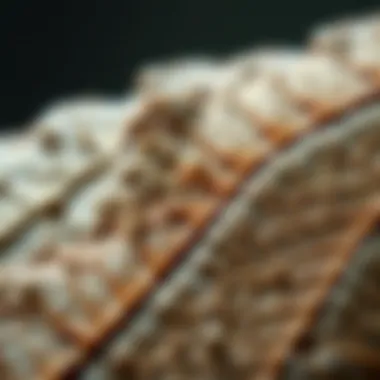Exploring the Market for Plant Fossils: A Collector's Guide


Intro
The world of plant fossils is a fascinating one, blending science, history, and art into an enticing collection of specimens. As collectors and enthusiasts seek to deepen their understanding of these remnants from the distant past, the market for plant fossils has grown increasingly dynamic and diverse. With so many dimensions to explore, from their historical context to practical tips for acquisition, it’s essential to grasp both the allure and importance of these artifacts.
In this discourse, we'll journey through the significance of plant fossils, examining how they contribute to both scientific research and the collector market alike. We will shed light on the various types of plant fossils that can be found, their origins, and what to consider before making a purchase. By the end, readers will possess a comprehensive understanding of the market trends in plant fossils, ensuring informed and satisfying collecting experiences.
History and Origins
Overview of Collectibles, Rocks, and Fossils
Plant fossils have been collected since ancient times, but the structured practice of fossil collecting truly took off during the late 18th and early 19th centuries. This was a period marked by burgeoning scientific curiosity, where items like trilobites and plant imprints were passionately sought after. Much like today’s collectibles, the allure lay in their rarity, beauty, and the stories they could tell about Earth’s history.
- Types of Fossils: Plant fossils can be broadly categorized into several types such as leaf impressions, seeds, and even entire plants preserved in amber. Each type offers a different glimpse into prehistoric life, making them essential for both scientific and aesthetic appreciation.
- Acquisition Methods: Collectors may get their hands on these fossils through various channels, including fossil fairs, auctions, or specialized online platforms. Understanding the nuances of each method can aid in pure enjoyment and successful transactions.
Historical Significance and Cultural Impact
Plant fossils do not merely sit pretty on shelves; their significance runs deep within various fields of study.
Prelude to Plant Fossils
The realm of plant fossils holds a certain mystique, calling to mind ancient forests and the intricate tales of life that thrived long before our time. The importance of exploring plant fossils extends far beyond mere curiosity; these remnants of the past are critical for understanding the evolution, diversity, and adaptations of plant life. This section will guide you through the essential aspects of plant fossils, setting the stage for deeper dives into their various types, market dynamics, and significance in scientific contexts.
Definition of Plant Fossils
Plant fossils represent the preserved remains or traces of ancient plants, often dating back millions of years. They can take various forms, from the actual skeletal structures of plants to impressions left in sediment. These fossils are not just lifeless artifacts; they provide profound insights into the biology of ancient flora, revealing crucial information about the environment in which they existed.
The most common types of plant fossils include impressions of leaves, remnants of wood, and even structures like pollen grains that can tell us a lot about reproductive strategies of long-extinct species. Fossils are discovered through geological processes, and their location often reflects the ecological conditions present at the time of their formation. For example, a leaf fossil found in a once-subtropical area might indicate a vastly different climate from today. Each fossil unfolds a story, unique in its context, contributing to our understanding of prehistoric ecosystems.
Importance of Plant Fossils in Paleontology
Plant fossils play a foundational role in the field of paleontology and environmental science. Here are a few critical points to consider:
- Biological Indicators: Fossils act as biological indicators, helping scientists reconstruct ancient ecosystems. By analyzing plant remains, researchers can infer climatic conditions and shifts over geological time scales.
- Evolutionary Insights: They provide valuable information on how plant species have evolved throughout history, allowing us to track changes in biodiversity and plant interactions with other species, including insects and animals.
- Climate Records: The study of plant fossils is essential for understanding past climates, which directly informs current models of climate change.
- Conservation Relevance: Understanding how plants adapted during historical climate shifts can guide conservation efforts today, offering templates for resilience in modern species.
"Every plant fossil is a window to the past, shedding light on the life forms and conditions of times long gone."
As we delve deeper into this article, we will explore the various types of plant fossils available on the market, their valuation, and how to care for them, ensuring that collectors and enthusiasts are well-equipped with the knowledge to appreciate these ancient treasures.
Types of Plant Fossils for Sale
Understanding the variety of plant fossils available for sale is crucial for collectors and enthusiasts alike. Each type of fossil carries its own unique story, offering insights into prehistoric ecosystems that are otherwise hard to imagine. This section will delve into the distinct categories of plant fossils, discussing their characteristics, the science behind them, and the appeal they hold for collectors. By exploring these types, buyers can make more informed decisions and potentially discover rare specimens that pique their interest.
Amber Fossils
Amber fossils are not just beautiful; they carry significant historical value. Amber, fossilized tree resin, often encapsulates small organisms such as insects, spiders, and even plant material. The clarity and color variations of amber can tell you a lot about its origin and age. It can range from golden yellow to deep brown, sometimes displaying a stunning translucence that allows one to catch a glimpse of whatever it holds within.
Collecting amber fossils comes with its own set of considerations:
- Authenticity: Many sellers may offer synthetic or treated amber. It’s important to know how to distinguish genuine amber from its imitations. Testing for buoyancy or using ultraviolet light can be helpful.
- Preservation: The quality of what’s trapped inside amber can vary. For example, a tiny insect preserved perfectly has much higher value than one that is significantly damaged.
Amber fossils hold a certain allure for those looking to add something extraordinary to their collection. The stories they tell transcend time and can evoke a sense of wonder about life millions of years ago.
Leaf Impressions
Leaf impressions are another fascinating category, revealing intricate details of plant life from ancient times. These fossils capture the exact shape and venation of leaves, making them invaluable to paleobotanists studying past ecosystems. Leaf impressions typically form when sediment envelops fallen leaves, creating an imprint that hardens over time.
When collecting leaf impressions, keep a few points in mind:
- Diversity: There exists a wide variety of leaf types, each telling its own story. Some are well-preserved, showcasing the sharp details of the leaf structure, while others may be less defined.
- Origin: Knowing where a leaf fossil came from can add to its value. Certain fossil beds are famous for their diverse and well-preserved leaf impressions, making them sought-after among collectors.
Leaf impressions provide collectors not only with unique decor but also with a tangible connection to the historical natural world.
Wood Fossils


Wood fossils, or petrified wood, offer a robust insight into ancient forests. These specimens are formed when wood becomes buried under sediment and undergoes a process called permineralization. Over millions of years, minerals gradually replace the organic material, turning the wood into stone. The result is often stunning, with vivid patterns and colors.
Core aspects to consider when looking into wood fossils include:
- Color and Pattern: The mineral composition greatly influences the appearance of wood fossils. Some may show vibrant hues and intricate patterns, resembling polished stone.
- Size and Shape: Larger specimens can command higher prices, but even smaller pieces can be captivating. Collections often feature slices of petrified wood, showcasing cross-sections of these ancient trees.
For collectors, wood fossils represent an intersection of art and science, exemplifying the beauty of nature's transformations over eons.
Pollen and Spores
While often overlooked, pollen and spores hold crucial information about past climates and ecosystems. These microscopic fossils are remnants from various plant species, providing significant data on plant evolution and environmental changes. Collecting them requires keen attention as they are often found only in sedimentary deposits.
Important factors to consider with pollen and spores:
- Identification: Determining the species from which pollen or spores originated can be challenging. Utilizing microscopy can aid in making accurate identifications.
- Historical Significance: These tiny fossils can offer broader insights into ancient climates. Understanding which plants thrived at a certain time can give clues about temperature and environmental conditions.
Collecting pollen and spores not only enriches a collection but also contributes to scientific understanding. Enthusiasts find value in these tiny wonders for their clarity on life’s adaptability through time.
In summary, each type of plant fossil offers not just aesthetic appeal but also scientific significance, making them valuable additions to any collector's trove.
The Market for Plant Fossils
Understanding the market for plant fossils is crucial for collectors and enthusiasts alike. It’s a niche that combines aesthetics, history, and science. The allure lies not just in owning a piece of the past, but also in the stories these fossils tell about Earth’s botanical history. When diving into this market, one must consider where to buy, how prices are set, and the unique attributes of various plant fossils.
Additionally, navigating the complexities of this market provides significant insights into buying behaviors and collector motivations, which are essential when making informed decisions. The interest in plant fossils has grown, driven by both scientific curiosity and the desire for unique decorative pieces.
Where to Buy Plant Fossils
Online Marketplaces
Online marketplaces have revolutionized how collectors find plant fossils. Websites like eBay and Etsy offer an extensive range of options from various sellers, making it a popular choice for many. Here, buyers can access a broad variety of specimens from across the globe, often at competitive prices. However, the downside includes the challenge of validating the authenticity of fossils due to the lack of personal inspection. The online atmosphere can foster both excitement and apprehension, as it requires trust in the seller and their claims about the fossil's origin.
- Advantages:
- Disadvantages:
- Wide selection across different price ranges
- Convenient shopping experience, accessible from home
- Ability to compare options easily
- Risk of counterfeit items
- Shipping concerns, especially for fragile specimens
Specialized Fossil Shops
Specialized fossil shops often provide a more personalized experience. These establishments focus solely on fossils, giving collectors a knowledgeable environment to delve into their interests. A significant aspect of these shops is the expertise of the staff, making it easy to ask questions about fossils' history and significance. Shopping here usually allows for direct inspection and examination of the specimens, fostering a relationship between the buyer and the item that online settings often lack.
- Advantages:
- Disadvantages:
- In-depth expertise from knowledgeable staff
- Opportunity to physically examine fossils before purchasing
- Often offer guarantees of authenticity
- Limited selection compared to online options
- Pricing might be higher due to overhead costs
Fossil Shows and Expos
Fossil shows and expos serve as vibrant hubs for enthusiasts and professionals alike. These events bring together a large number of vendors and collectors from different walks of life, creating a bustling atmosphere full of both education and commerce. A standout feature of these gatherings is the ability to network, meeting fellow collectors, and professionals, and discussing the nuances of fossils face to face. Seeing artifacts in person and the chance to negotiate prices can lead to unique finds and connections.
- Advantages:
- Disadvantages:
- Diverse array of fossils and educational opportunities
- Immediate access to expert advice
- Networking potential with other collectors
- Events might be seasonal or location-specific
- Crowds can make for a less personal experience
Price Ranges and Valuation
Factors Affecting Price
The price of plant fossils can vary dramatically based on several factors. Key considerations include rarity, size, and condition of the fossil. Rarer specimens typically command higher prices, while those in exceptional condition can also draw a premium. Additionally, the fossil’s provenance can significantly affect its value, as a well-documented history adds to its desirability. Buyers should be aware that factors such as market demand and trends can also influence valuation over time.
- Advantages:
- Disadvantages:


- Understanding these factors can lead to better purchasing decisions
- Helps in recognizing genuine value versus inflated pricing
- Can complicate the buying process for inexperienced collectors
Comparative Value Analysis
Conducting a comparative value analysis is an effective approach for anyone serious about investing in plant fossils. This involves evaluating similar items to establish a baseline for what a fair price looks like, considering the factors previously mentioned. A detailed examination of price trends over time for similar specimens can illuminate how demand fluctuates based on time and market conditions.
- Advantages:
- Disadvantages:
- Aids in informed negotiation and decision-making
- Helps to recognize market trends for better investments
- Requires some level of understanding of the fossil market and trends
By exploring these aspects of the plant fossil market, collectors can navigate their way through buying decisions with confidence, ensuring they make informed choices while contributing to the preservation of Earth’s ancient botanical history.
Assessing Quality in Plant Fossils
Assessing the quality of plant fossils is essential for enthusiasts and collectors alike. It's not just about the aesthetic appeal; it’s about understanding the integrity and scientific value of these ancient specimens. A well-preserved fossil can offer insights into prehistoric ecosystems, while a poorly assessed one may mislead or disappoint the buyer. Here, we’ll break down the pivotal elements involved in evaluating plant fossils, honing in on authenticity and preservation.
Identifying Authenticity
Authenticity is the backbone of any fossil's value. A fossil that's genuine not only holds educational worth but can also appreciate in value over the years. To identify authenticity, a collector should start by analyzing key characteristics:
- Texture and Feel: Genuine fossils often have a distinct texture due to mineralization over time. They should feel dense and heavy, not just like a lightweight rock.
- Visual Inspection: Check for bubbles or irregularities in the specimen's surface. These could indicate that the piece has been artificially created or altered. Compare your findings with authentic examples from verified sources.
- Expert Endorsement: If in doubt, consult a paleontologist or a recognized fossil dealer. Their trained eyes can spot discrepancies that the average buyer might miss.
In short, it pays to do your homework about each fossil, relying on a mix of your own observations and professional guidance.
“A good collector not only buys with their eyes but also with their knowledge.”
Understanding Fossil Preservation
Once authenticity is confirmed, the next step is understanding how well-preserved the fossil is. Preservation can significantly influence both the scientific insight a fossil offers and its market value. Here are key aspects to consider:
- State of Preservation: Plant fossils range significantly in how well they have survived the ages. Look for details like color retention, clarity of shapes, or intact cellular structures; these features signal that the fossil has been well-preserved.
- Environmental Factors: Factors like water saturation, heat, or exposure to elements during the fossilization process can affect preservation. Research the geographic and geological context where the fossil was discovered to understand its preservation history better.
- Restoration History: If the fossil has been restored or repaired, this should be disclosed by the seller. While skilled restoration can enhance a specimen, excessive repairs can detract from its original value. Always ask for documentation outlining any restoration done.
Investing in excellent quality fossils is not just about money. Ensuring that your collection maintains a standard enhances both its educational and emotional value.
Caring for Plant Fossils
Caring for plant fossils is an essential aspect of fossil collecting that often gets overlooked. Proper care helps ensure the preservation of these historical treasures, enhancing their longevity and maintaining their aesthetic qualities. As a collector or enthusiast, understanding how to care for these fossils not only enriches your collection but also showcases your respect for natural history. Small steps in proper maintenance and storage can make a world of difference.
Cleaning and Maintenance Best Practices
Cleaning plant fossils requires a gentle touch. Unlike traditional artifacts, fossils may have delicate structures that can easily be damaged. Here are some best practices:
- Gentle Dusting: Use a soft brush, like a paintbrush, to remove dust. This prevents scratches and preserves fine details.
- Avoid Water: Refrain from using water or solvents, as these can seep into the fossil and cause irreversible damage. If stubborn dirt is present, a damp cloth with just a drop of soap can be tried—always ensure it is barely damp.
- Check for cracks: Regularly inspect your fossils for any signs of cracking or degradation. Identifying issues early can help prevent further damage.
- Professional Advice: If a fossil requires deep cleaning, consider consulting a restoration expert.
Cleaning not only makes fossils visually appealing but also protects their scientific integrity, especially for those with historical significance.
Storage Considerations
The way fossils are stored can significantly impact their condition over time. Here are guidelines to ensure proper storage:
- Temperature and Humidity: Store fossils in a stable environment. Avoid extreme temperature fluctuations and high humidity, as these can accelerate deterioration.
- Display Cases: Use display cases made from UV-filtering glass to protect fossils from sunlight, dust, and pollution. If you are displaying them, avoid direct sunlight.
- Avoid Pressure: Do not stack fossils on top of one another; this can lead to cracks and impressions from weight. Instead, use padded containers or individual boxes.
- Labeling: Ensure that your fossils are properly labeled, keeping track of their provenance and significance. This serves both practical and educational purposes.
Proper care measures not only preserve the beauty of plant fossils but also safeguard their value as artifacts of natural history.
By understanding and implementing these care practices, collectors can ensure that their plant fossils survive the test of time, allowing future generations to appreciate their beauty and significance. The right approach to maintenance and storage enhances the personal connection collectors have with their finds, making the experience even more rewarding.
Scientific Significance of Plant Fossils
Understanding plant fossils goes beyond just curiosity about past life; it’s crucial for comprehending the earth’s biological history. These relics hold the keys to secrets buried under layers of time, and we as scientists and collectors have the responsibility of unraveling them. They carry immense importance in several domains: from paleobotany to climate studies, and more.
Role in Understanding Ancient Ecosystems


Plant fossils are essential for piecing together the puzzle of ecosystems that flourished ages ago. They reveal how flora responded to various environmental changes over millions of years. For example, the discovery of a specific leaf type can signal the presence of a certain climate or habitat. The climatic preferences of a plant species can often indirectly relate to geological activity and even animal evolution.
Researchers studying these fossils use techniques such as stratigraphy to analyze the layers of sediment in which they are found. This not only provides a chronology but also valuable insight into the diversification of plant species over time. The cyclical nature of extinction and evolution becomes evident; when one species died out, others thrived. The fossil record shows which plants were survivors and which were adapted to drastic environmental shifts, painting a vivid picture of ancient life.
"The past is a prologue to the present; our ecological challenges today have roots stretching back into the history of plant life on Earth."
This facet of plants in the fossil record is a treasure trove for scientists. Extracting data from these specimens can lead to understanding how plants adapt to challenges such as drastic temperature fluctuations or changing soil conditions. This serves not only as a window to our planet's past but also as research data that could steer future conservation efforts.
Contribution to Climate Change Research
In the current climate crisis, the role of plant fossils takes on new urgency. By analyzing past climates through fossil evidence, researchers gain insights on how plants responded historically to increases in carbon dioxide levels and temperature. Studying periods like the Paleocene-Eocene Thermal Maximum, where rapid increases in global temperatures occurred, can inform us about potential outcomes of modern-day climate change.
The data extracted from fossilized plants allows scientists to devise models predicting how plants might behave under future climate scenarios. For instance, changes in leaf structure or growth patterns over geological epochs become key indicators for potential adaptations.
Utilizing plant fossils opens avenues for assessing biodiversity in a changing climate, crucial for both conservation and agriculture. Not only does it help in foreseeing possible extinctions, but the study of these plants can guide sustainable practices that aim to bolster resilience in ecosystems.
Recommended Resources
Ethical Considerations in Plant Fossil Collecting
Ethics in the realm of plant fossil collecting is a topic that, while sometimes neglected, carries immense significance. As collectors delve into the intriguing past that these natural artifacts unveil, they often face a crossroads that demands careful reflection on the moral and legal ramifications of their endeavors. Understanding the landscape of ethical considerations when it comes to fossil collection not only enhances the experience but also plays a vital role in the preservation of our planet’s natural heritage.
The act of collecting plant fossils isn’t simply a hobby; it’s an investment in cultural and scientific knowledge. When collectors engage with fossils, they are partaking in a legacy that can illuminate your understanding of ancient ecosystems, climate shifts, and evolutionary processes.
However, with great power comes great responsibility. Fossil collecting often intersects with legal and ethical challenges, particularly regarding behalf of both local and global conservation efforts. Thus, being informed about these complexities is essential for any serious collector.
Legal Aspects of Fossil Collection
When collectors dive into purchasing or trading plant fossils, it doesn't take long to discover that various legal frameworks govern fossil collection. These laws can vary widely based on location, making it crucial for enthusiasts to familiarize themselves with the regulations in their region.
- Ownership Rights: Different countries have different laws regarding who holds the rights to fossils. In some areas, fossils found on private land may belong to the landowner, while in public lands, specific regulations could apply.
- Permits and Restrictions: Collectors in the United States, for example, are generally allowed to collect on federal lands only with the appropriate permits. Ignoring these regulations can lead to significant penalties.
- Cultural Heritage: Many nations have strict laws protecting fossils considered part of their cultural heritage. Removing such fossils without proper permission can lead to legal repercussions and ethical dilemmas concerning heritage and identity.
It’s imperative to ask questions before making a purchase. Has the seller obtained the fossil legally? Are there any export restrictions? Understanding these legalities safeguards both the buyer and the seller. Protecting the integrity of the fossil market fosters a sustainable future for plant fossil enthusiasts.
Conservation Efforts and Responsibilities
Beyond legalities, the ethical dimensions of plant fossil collecting also extend to conservation responsibilities. Fossils are not merely items for display; they are invaluable records of our planet's history. Thus, the act of collecting should not only be about acquisition but also about sustainable stewardship.
- Preservation of Locations: Often, fossil sites are sensitive environments and contemporary collecting practices can lead to erosion or unintentional damage. Collectors should prioritize finding ways to collect that do not harm the surroundings.
- Sharing Knowledge: Engaging with the broader scientific community can help guide responsible practices. By sharing findings with researchers or participating in university-led projects, collectors can contribute to ongoing conservation efforts.
- Advocacy for Regulations: Supporting organizations that advocate for ethical fossil collection practices helps create a healthier ecosystem for fossil research and collection. Join local or national fossil associations that push for better regulations, ensuring sustainable collecting practices.
"The collector's responsibility does not end at ownership; it extends toward the legacy of our shared natural history."
For more information, you might check U.S. Fish & Wildlife Service or visit Paleontological Society to stay informed on best practices.
Future Prospects in Plant Fossil Research
As the field of paleobotany evolves, the future for plant fossil research looks captivating. The confluence of new technologies and innovative methodologies opens avenues for deeper understanding of ancient ecosystems and climate change. Researchers and collectors alike find themselves at the threshold of unprecedented insights, urging us to consider how these advancements can shape our comprehension of plant evolution and biodiversity. By exploring the forthcoming prospects in plant fossil research, we gain insight into its significance and benefits, pushing the boundaries of what is known in this specialized field.
Emerging Technologies in Fossil Analysis
Emerging technologies are drastically influencing the landscape of fossil analysis. Techniques such as X-ray micro-computed tomography (micro-CT) allow scientists to view internal structures without damaging the specimens. This non-invasive method reveals vital details hidden within the fossils, offering a clearer picture of plant anatomy and preservation state.
Moreover, advancements in genomics provide tools for extracting ancient DNA from well-preserved plant fossils. By studying genetic material, researchers can connect modern plants to their ancient counterparts, drawing evolutionary links that were previously mere speculation. This research is crucial for understanding species adaptation and extinction patterns.
Additionally, machine learning and artificial intelligence are making waves in fossil classification and analysis. With the ability to analyze vast amounts of data quickly, these technologies assist scientists in sifting through countless fossil specimens efficiently. Automated techniques can identify specific features of plant fossils, thus streamlining processes that once required manual labor and experience.
"Each leap in technology is a step towards not just understanding our past but preserving our heritage for future generations."
These innovations emphasize a growing need for researchers to adapt to changing methodologies. As tools become more sophisticated, the reliance on traditional techniques may evolve, potentially shifting how plant fossils are studied and categorized.
Trends in Plant Fossil Collecting
With scientific advancements, the landscape of plant fossil collecting is also undergoing significant changes. The desire for knowledge has prompted enthusiasts to seek not only rare specimens but also fossils that tell a story about environmental and climatic conditions of the past. Collectors now prioritize collecting specimens that are significant for scientific research and provide insights into the habitats and ecosystems of ancient periods.
Some noticeable trends include:
- Increased focus on locality and provenance: Collectors are showing a greater interest in the origin of fossils, adhering to ethical practices and ensuring sustainable sourcing.
- Collaborative collecting: There’s a noticeable shift where collectors are partnering with researchers, making contributions to scientific studies while building personal collections. This cooperative spirit enhances both research and collection practices, presenting an ethical framework for fossil enthusiasts.
- Emphasis on preservation: Modern collectors prioritize how to maintain their specimens. As awareness grows about conservation, many now adopt practices that ensure the longevity and stability of their collections, mitigating damage that may arise from neglect or improper storage.
These trends highlight the evolving relationship between collectors and the scientific community, creating a more informed and responsible collecting culture. As advancements in research merge with collecting, the future of plant fossil research not only enriches our historical understanding but also fosters ethical considerations in how these treasures are acquired and cared for.



